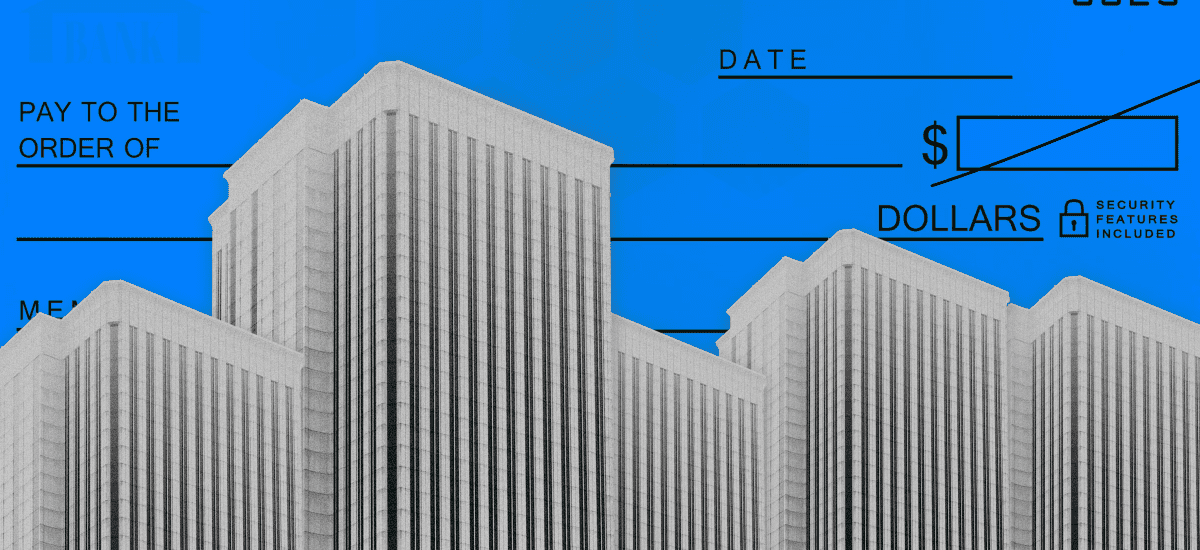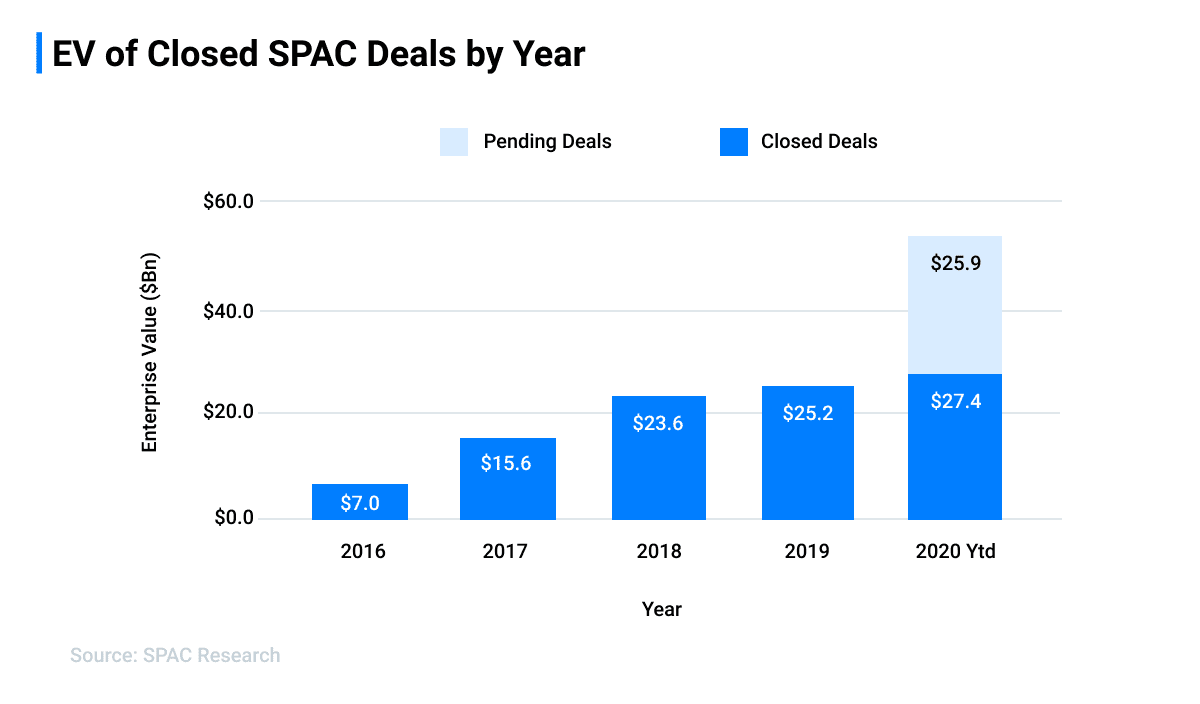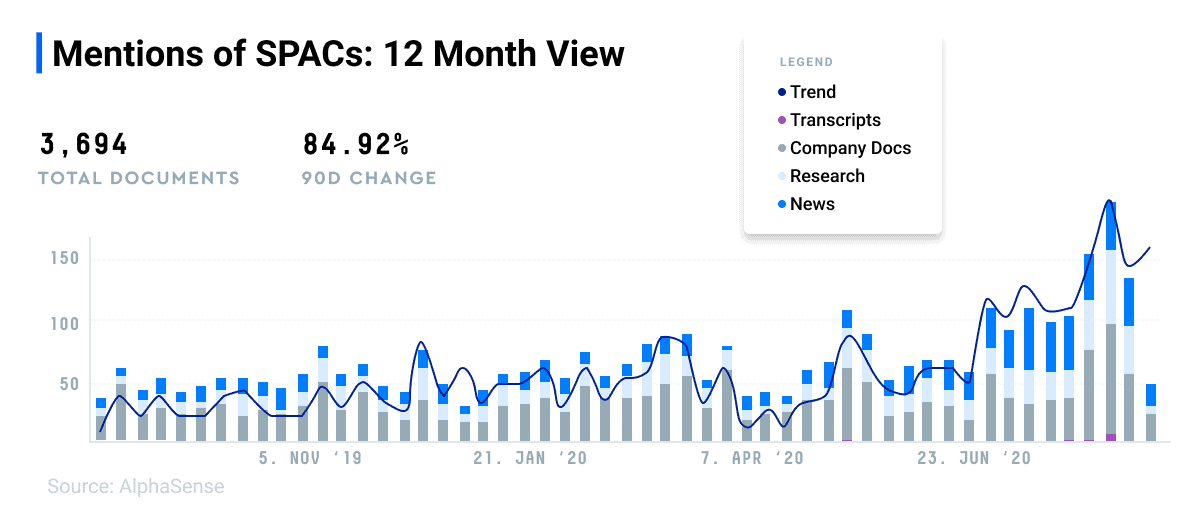Special Purpose Acquisition Companies are surging. Is this a secular change in how rising companies go public?
The dawning of the SPAC Age has been erroneously predicted every year for the past five or six years, as has the death of the IPO market. Is it different this time?
Takeaways
- SPACs, once dismissed as “blank-check” shells, have surged in issuance this year.
- Major investment banks are displaying sustained and increasing interest in this once-niche market and some respectable companies have pursued this path to going public.
- It remains to be seen if this higher level of interest in SPACs is a point-in-time aberration, or if it signals a permanent change in appetite for these vehicles.
Past
Not so long ago, a typical SPAC IPO had been valued under $150 million, and the whole market was less than $2 billion. On the strength of two major 2015 deals, the market suddenly doubled. From 2015 through 2019, SPACs trended upward, slowly at first, but gathering steam. Then, in the first half of 2020, more SPAC enterprise value was realized than in any previous full year, with almost as much volume pending. That is, even if there isn’t a single new SPAC issuance announced for the remainder of the year, and 90% of the pending deals close, volume will more than double year-over-year.
Figure 1: SPAC issuance by year. Pending value is as of July 20. Credit: SPAC Research
Present
“SPAC” is not, as many believe, a synonym for “blank check company.” Those have been around since at least the stock bubble, which preceded the Great Depression of the 1930s. While the SEC considers SPAC to be “a type of blank check company,” there are significant differences between the two. That’s why, according to the law firm Sutherland Asbill & Brennan, the SEC regulates them differently.
“A SPAC is exempt from regulation as a Blank Check Company under Rule 419 [of the Securities Act of 1933] on the basis that its net tangible assets exceed $5 million,” according to a 2016 presentation by Sutherland’s Cynthia M. Krus and Harry S. Pangas. They go on to discuss how Rule 419 places “onerous” requirements on how blank-check companies must:
- keep most offering proceeds in escrow along with any accrued interest,
- invest net proceeds only in Treasuries or cash equivalents,
- refrain from trading equity or warrants prior to completion of the merger,
- publicize any proposed merger with a prospectus and
- complete that merger within 18 months.
Still, SPAC underwriters tend to conform to the spirit of that law. Who those underwriters are is actually a little surprising. Banks that could ignore a $2 billion-per-year market can’t ignore a $50 billion-per-year market that, if this keeps up, will be a $100 billion-per-year market in 2021. Citigroup Global Markets, Credit Suisse Securities, UBS Securities and Goldman Sachs & Co. comprise more than half the market, according to SPAC Research, although they have plenty of competitors. There are also about 20 firms that serve as bookrunners, but don’t perform the lead underwriter function.
“When the first SPACs were created in the early 1990s, they were an obscure, somewhat dubious funding vehicle. Since then, however, the quality of the deal sponsors has significantly improved and the average size of the offerings has increased dramatically,” according to Mohsin Y. Meghji, founder and managing partner of M-III Partners. “Today, SPACs are an accepted institutional investment class. Many are sponsored by leading investment firms, underwritten by leading investment banks, and purchased by well-respected institutional investors. With these changes, SPACs are now considered respectable merger partners and well-established companies have completed a wide range of successful combinations with them.”
What attracts these august institutions, though, is the quality of acquisitions that SPACs have been able to secure, as well as the quality of management going into creating these firms. Pershing Square Capital Management created its own vehicle, Pershing Square Tontine, the largest SPAC to go ever go public according to Renaissance Capital. Meanwhile, healthcare cost management company MultiPlan merged into SPAC Churchill Capital III for an unprecedented $11 billion. And Therapeutics Acquisition, the first SPAC IPO of common shares, saw a 20% first-day pop – and that in itself is what probably drew all the attention. Still in all, the events noted in this short paragraph speak to a pretty frothy six months.
The result is a spate of successful public offerings via SPACs in the past few months (see sidebar). Many of these have been in the electric vehicle or fintech spaces, but there have also been high-profile deals involving such recognizable brands as DraftKings or Virgin Galactic.
Future
Growth in SPACs might be coming at the expense of IPOs, which have yielded a steady $200 billion annual market value, based on around 200 new issues per year. That is to say, SPACs are already a quarter of the way toward being just as big.
Mentions of SPACs in company documents, news articles, and broker research have increased significantly over the past 12 months
Direct listings are also worth consideration, but let’s not get too far ahead of ourselves. This avenue isn’t popping the way SPACs are at the moment. In the days before the pandemic, Spotify and Slack famously went this route, but has anyone since? Name recognition isn’t everything. In 2012, Facebook decided to use Etrade as an IPO underwriter; that did not start a trend.
IPOs, SPACs and direct listings are the three major choices available now for companies seeking to go public, and they all have their pluses and minuses. IPOs travel a well-paved road with clear regulatory rules and the ability to raise primary capital. But it’s an expensive route.
SPACs, according to Morgan Stanley, provide greater initial liquidity than IPOs while following a faster, simpler process. Still, the initial share price is just a matter of what the fickle market will bear, which injects a degree of uncertainty that disadvantages both investors and target companies. Direct listings offer the highest degree of liquidity and the lowest fees of the three options, but has all the negatives of any small, immature market.
But it would seem that the current procedure – raising capital through PE, waiting around for the right time to go public, engaging an underwriter, filing with the SEC, paying all kinds of money to all kinds of capital markets hangers-on, then kicking yourself for guessing either too high or too low when setting your share price – is ripe for disruption. If the PE and IPO phases can be condensed, that might make for a more efficient – if perhaps less transparent – market.
“A company that wants to go public should do its due diligence on its options, and really think about what it’s trying to achieve and the purpose of the listing. Is it trying to raise capital? Provide liquidity?,” according to a recent Crunchbase News article. “Nasdaq doesn’t have a preference … and it will support corporate pre-listing, the day of, and after it goes public. But companies need to do their research and choose the path that will set them up for success in the future.”
Interested in staying up-to-date on SPACs? Login to AlphaSense to set up alerts or start a free 2-week trail
AlphaSense can help you stay up-to-date on SPACs, IPOs, and Direct Listings. Start your free trial of AlphaSense or login now to explore the data.
Noteworthy SPACs
| SPAC | Symbol | Trust Account (x$1m) | Target Sector | Announced acquisitions |
| Pershing Square Tontine | PSTH.U | 4,000 | Large-cap growth | |
| Foley Trasimene II | BFT.U, | 1,300 | Fintech | |
| Churchill Capital III | CCXX.U | 1,104 | Not specified | MultiPlan |
| GS Acquisition Holdings | GSAH2 | 750 | Diversified | |
| Flying Eagle Acquisition | EAGL6 | 691 | Not specified | |
| Jaws Acquisition | JWS.U | 690 | Growth-oriented | |
| Dragoneer | DGNR.U | 690 | Diversified | |
| Far Point Acquisition | FPAC.U | 651 | Fintech | Global Blue |
| RedBall Acquisition | RBAC.U | 575 | Sports | |
| Spartan Energy Acquisition | SPAQ.U | 569 | Energy | Fisker |
| Collier Creek | CCH.U | 453 | Food | Utz |
| FinTech Acquisition III | FTAC.U | 353 | Fintech | Paya |
| Diamond Eagle Acquisition | DEAC.U | N/A | Not specified | DraftKings |
| Social Capital Hedosophia | IPOC | N/A | Not specified | Virgin Galactic |
| VectoIQ Acquisition | VTIQ | N/A | Not specified | Nikola |
| Hennessy Capital Acquisition | HCAC.U | 309 | Diversified | Canoo |
| Diamond Peak | DPHC.U | 284 | Real estate | Lordstown Motors |
| Tortoise Acquisition | SHLL | N/A | Not specified | Hyliion |
Source: AlphaSense. For more noteworthy SPACs, start your free trial of AlphaSense or login now to explore the data.





